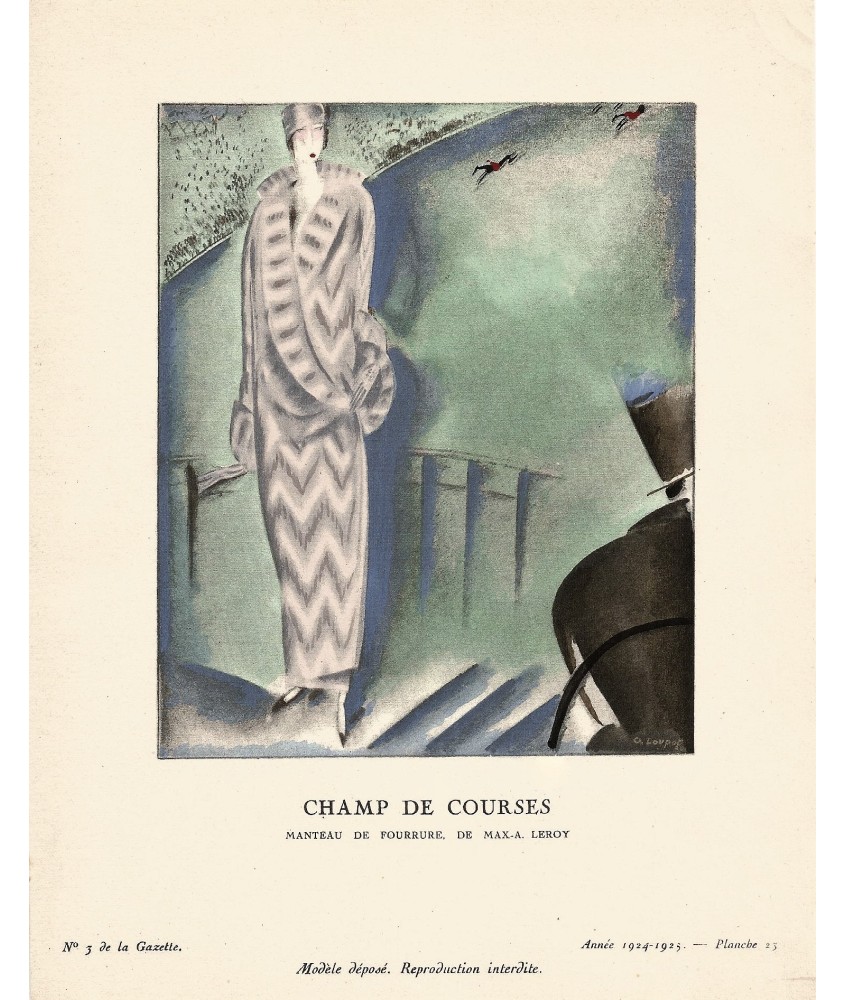- Out-of-Stock


Nº 3 DE LA GAZETTE DU BON TON. PLANCHE 23. 1924-1925.The Gazette Bon Ton, put out by the retailer of the same name, was considered the trendsetting magazine of the era. Founded by Lucien Vogel and targeting Paris's upper class, it ran from 1912-1925. Only ten colour plates were printed per issue, and artists vied for the prestige of illustrating the latest Parisian fashion and lifestyle trends. As these pochoirs attest, the high style and iconic femininity made the items featured in the pages "must have's" Charles Loupot, whose career spanned from 1916 until 1960, remains in poster history as one of the major creators of the interwar period, alongside Cassandre, Jean Carlu and Paul Colin
Charles Loupot, whose career spanned from 1916 until 1960, remains in poster history as one of the major creators of the interwar period, alongside Cassandre, Jean Carlu and Paul Colin. He resided mainly in Paris, owned a country house in Chevroches, in the Nièvre, and properties in Arcs-sur-Argens.
From 1907 to 1910, he lived with his parents in Lausanne1, in Switzerland. A pupil of the Lyon School of Fine Arts from 1911 to 1913, he participated in the First World War. Charles was injured in 1914. Reformed, he then moved to Geneva, then returned to settle in Lausanne in 1917. Then opened for him, until 1923, the Swiss period. In this country, he abandoned painting and drew more than 60 poster projects for Swiss printers who taught him the constraints and resources of lithographic stone.
He returned to France in 1923. Noticed by French printers Devambez2, he created an impressive series of posters, notably for Voisin3 cars, Galeries Barbès furniture, Peugeot, Twining tea, Ocap, Valentine paintings, products now mass-produced. He settled in 1931 in a workshop in Montmartre. He notably created the posters La glace Sécurit in 1931, Dop in 1935, Ambre solaire in 1936, Coty in 1938.
From 1937, Loupot worked for the aperitif brand St Raphaël Quinquina, whose visual identity he gradually changed.
During the Occupation, Loupot lived in his house of Chevroches where he mainly painted. Advertising for liquors having been banned by the Vichy regime, his work for St Raphaël stopped, to resume after the war. Advertising for alcohol was authorized in 1950, St Raphaël again became known. The advertising that Loupot develops for this brand is disseminated on numerous derivative products; it is reproduced on multiple supports, in particular painted walls. In 1950, the advertising agency "Les Arcs" was created in Paris, of which Loupot is the artistic director. Loupot also worked for Nicolas wines and produced posters for Lion Noir in 1949, Vichy Célestins in 1953, the Provencal Olive Fair in Draguignan in 1954, Route et ville in 1957, before designing the Air Liquide logo. .
Loupot's parents had acquired property in the Arcs-sur-Argens in the Var in the 1920s. He regularly stays in this city where he settles in his last years. When the municipality decides to restore the old district of Parage, he convinces the municipality to define rigorous specifications so that the work is done in a harmonious manner. He used his notoriety to find the first buyers, highly visible Parisians.
After his disappearance, the French Medal Club struck a medal in his effigy in 1973, produced by Marcel Jacno. A biography, by Christophe Zagrodzki, was published in 19984. FR3 Bourgogne co-produced in 2000 a film by Jacques Tréfouël, Charles Loupot or the birth of the modern poster. The Romain Rolland Art and History Museum in Clamecy (Nièvre), near Chevroches, devotes a permanent exhibition hall to Loupot. The towns of Arcs-sur-Argens, Clamecy and Échirolles give the name of Charles Loupot to one of their routes.